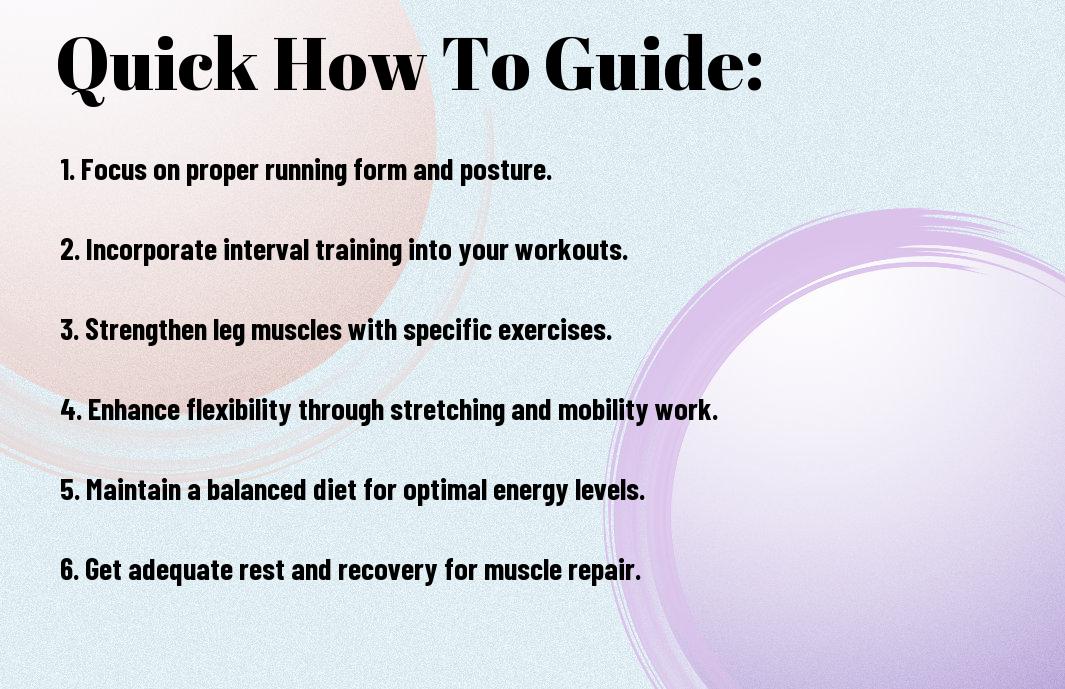Enhancing your sprinting speed is an attainable goal, and it begins with understanding key techniques and strategies. By focusing on your form, strength training, and proper conditioning, you can make significant strides in your performance. This guide will provide you with actionable steps to help you develop explosive power and increased efficiency, allowing you to reach your sprinting potential. Get ready to transform your training and experience measurable improvements in your speed.
Key Takeaways:
- Form: Proper running form enhances efficiency; focus on posture, arm movement, and foot placement.
- Strength Training: Incorporate leg and core strength exercises to build muscle power and enhance speed.
- Interval Training: Utilize high-intensity interval workouts to boost stamina and speed in sprints.
- Flexibility: Regular stretching and mobility work can improve range of motion and reduce injury risk.
- Nutrition: Fuel your body with the right nutrients to support energy levels and recovery for optimal performance.
Understanding Sprinting Speed
While many elements contribute to sprinting speed, recognizing the fundamentals can help you maximize your performance. Sprinting speed isn’t just about how fast you can run; it involves a combination of techniques, physical conditioning, and mental focus. By understanding these components, you can develop a more effective training regimen and experiences that boost your overall sprinting capabilities.
Key Factors Affecting Speed
On your journey to improve sprinting speed, several key factors will come into play:
- Technique, including body posture and stride efficiency
- Leg strength and power
- Endurance and recovery
- Application of explosive energy
- Body weight and composition
The combination of these elements can significantly influence your sprinting performance.
The Science of Sprinting
Sprinting involves various physiological processes that contribute to how fast and efficiently you can run.
The primary energy source for sprinting comes from anaerobic metabolism, which allows you to produce quick bursts of energy without relying on oxygen. Your muscle fibers play an imperative role, as fast-twitch fibers are responsible for explosive movements, while the central nervous system helps coordinate these actions. Additionally, biomechanics—like the angle of your joints and the force applied with each stride—also significantly affect your speed, so understanding these principles is key to improving your sprinting performance.

How to Assess Your Current Speed
If you want to enhance your sprinting speed, assessing your current capabilities is the first step. This involves measuring your sprinting time and understanding your physical attributes. By analyzing your current performance, you can set targeted goals and develop a tailored training plan to improve your speed effectively.
Measuring Your Sprint Time
Current sprint time is an important metric for evaluating your speed. To measure this, find a flat, undisturbed track or surface and use a stopwatch or a timing app. Sprint a standard distance, like 40 meters, and record your time. This data serves as a benchmark, which you can use to track your progress over time.
Identifying Strengths and Weaknesses
Weaknesses in your sprinting technique or physical conditioning can significantly hinder your performance. To identify these areas, analyze your sprinting form and assess your endurance, flexibility, and strength. This insight will allow you to pinpoint specific aspects to focus on in your training regimen.
Assess your sprinting mechanics by observing your body posture, stride length, and frequency. You can do this by recording yourself during a sprint or by asking a coach for feedback. Once you have identified your strengths and weaknesses, you can create a more focused and effective training plan that builds on your strengths while addressing your areas of improvement.
Tips for Improving Sprinting Technique
Many athletes overlook the importance of sprinting technique, yet enhancing it can significantly boost your speed. Here are some tips to elevate your sprinting form:
- Focus on maintaining a neutral spine.
- Keep your head aligned with your body.
- Engage your core throughout the sprint.
- Shorten your stride for better efficiency.
Assume that perfecting your technique will lead to faster and more effective sprints.
Proper Form and Posture
Assuming you maintain an upright position while sprinting will enhance your performance. Your knees should drive up, and your hips should stay aligned above your feet. This encourages optimal power transfer and minimizes energy loss with each step.
Effective Arm Movement
On the other hand, effective arm movement is key to improving your speed. Your arms should move in sync with your legs, propelling you forward and adding momentum to each stride. A 90-degree bend at the elbows allows for optimal swing and helps drive your legs faster.
Proper arm movement involves swinging your arms back and forth, maintaining a relaxed grip to avoid tension. Your arms should cross the midline of your body slightly, enhancing rotation and rhythm. This synchronization with your leg movements will make you more aerodynamic, allowing you to cover ground more quickly and efficiently.
Strength Training for Sprinters
All sprinters looking to enhance their speed should focus on strength training as it builds the muscle power needed for explosive starts and fast acceleration. Incorporating a variety of targeted exercises can help you develop the necessary strength and stability in your legs and core. You’ll find that a well-structured strength training program can significantly improve your sprinting mechanics, allowing you to run faster and more efficiently.
Key Exercises for Power
On your journey to boost sprinting speed, prioritize key exercises like squats, deadlifts, and power cleans. These compound movements engage multiple muscle groups, fostering strength and explosiveness. Additionally, you should consider adding exercises like lunges and leg presses, as they improve your overall leg power while reinforcing the muscles you use during sprints.
Incorporating Plyometrics
The addition of plyometrics to your training routine can dramatically enhance your sprinting speed. By focusing on explosive movements, such as jump squats, box jumps, and bounding, you’ll develop not only your strength but also your ability to generate speed quickly. These exercises help improve your muscle fiber recruitment and reaction time, leading to faster runs.
Another effective way to integrate plyometrics into your training is by incorporating drills that emphasize speed and agility. Activities such as hurdle hops, lateral bounds, and depth jumps can further enhance your explosive power and coordination. As you progress, aim to increase the intensity and complexity of these drills, ensuring your body adapts to the demands of sprinting. Balancing plyometric exercises with your regular sprint training will maximize your potential on the track.

Speed Workouts and Drills
Despite the physical demands of sprinting, incorporating speed workouts and drills into your training regimen can significantly enhance your performance. These specialized exercises focus on building strength, agility, and quickness, making you a more efficient sprinter. Engage in consistent speed workouts to unlock your potential and achieve your desired sprinting goals.
Interval Training Techniques
Drills such as interval training are excellent for boosting your sprinting speed. By alternating between high-intensity sprints and moderate recovery periods, you increase your cardiovascular capacity and muscular endurance. This method helps you push beyond your limits while allowing your body to recover sufficiently before your next effort.
Sprinting Drills for Improvement
To further enhance your sprinting performance, focus on targeted sprinting drills that improve your technique and efficiency. These exercises, including high knees, butt kicks, and bounding, build explosive power and enhance your running form, ultimately contributing to a faster sprinting speed.
Interval training drills can vary in duration and intensity based on your fitness level. For instance, you might perform 30-second sprints followed by 2 minutes of light jogging or walking, repeating this for several rounds. This approach not only builds speed but also develops your mental toughness. As you progress, you can reduce the recovery time to maximize your sprinting capabilities effectively.
Nutrition and Recovery Strategies
Unlike many sports, sprinting requires not just speed but also optimal nutrition and recovery strategies to enhance performance. You must fuel your body with the right nutrients and allow sufficient time for recovery to reap the benefits of your training. Implementing a balanced diet and prioritizing recovery can lead to improved sprinting speeds and overall athletic performance.
Essential Nutrients for Athletes
There’s a strong emphasis on incorporating carbohydrates, proteins, and fats into your daily diet as an athlete. Carbohydrates provide the necessary energy for high-intensity sprinting, while proteins support muscle repair and growth. Healthy fats help sustain your energy levels, ensuring you can perform at your peak during workouts and races.
Importance of Rest and Recovery
There’s a significant impact of adequate rest and recovery on your sprinting performance. Without allowing your body time to recuperate, you risk burnout and injury, which can hinder your progress. Prioritizing rest will not only enhance your physical capabilities but also support mental clarity for your training sessions and competitions.
Athletes often underestimate the value of rest and recovery in their training regimen. Quality sleep restores energy, repairs muscles, and helps prevent overtraining, which can stall your improvements. Implementing regular rest days and active recovery techniques, like stretching and foam rolling, can enhance your performance and keep you fit for your sprinting goals.
Conclusion
The key to improving your sprinting speed lies in a combination of proper technique, strength training, and consistent practice. Focus on enhancing your running form to maximize efficiency, incorporate exercises that build your lower body strength, and integrate sprint drills to develop your explosive power. Additionally, prioritize recovery and nutrition to ensure your body is well-equipped to adapt and improve. By consistently applying these principles, you will see significant advancements in your sprinting performance.
FAQ
Q: What are some effective exercises to enhance sprinting speed?
A: To improve sprinting speed, incorporate exercises that focus on explosive power, strength, and speed development. Key exercises include:
- Short Sprints: Perform 20-40 meter sprints with full recovery between efforts.
- Hill Sprints: Running uphill helps build strength and speed simultaneously.
- Plyometric Drills: Exercises like box jumps and bounding can enhance power output.
- Strength Training: Incorporate squats, deadlifts, and lunges to build the leg muscles used in sprinting.
- Form Drills: Focus on drills like high knees and butt kicks to improve technique and efficiency.
Q: How can I improve my sprinting technique for better speed?
A: To enhance your sprinting technique, focus on several key elements:
- Proper Posture: Maintain an upright posture with a slight lean, keeping your head aligned with your spine.
- Arm Movement: Use your arms for propulsion; they should move in sync with your legs, driving back and forth.
- Foot Placement: Aim to land on the balls of your feet for optimal force generation and minimize ground contact time.
- Stride Frequency: Work on increasing your cadence by taking quicker, shorter steps while maintaining power.
- Relaxation: Stay relaxed in your shoulders and hands to avoid transferring tension into your stride.
Q: What role does nutrition play in improving sprinting speed?
A: Nutrition significantly impacts performance and recovery in sprinting. Focus on the following nutritional strategies:
- Balanced Diet: Consume a diet rich in complex carbohydrates, lean proteins, and healthy fats to fuel your training.
- Hydration: Stay well-hydrated to maintain peak performance and recovery. Dehydration can lead to fatigue and slower speeds.
- Pre-Workout Nutrition: Have a meal or snack containing carbohydrates and protein about 1-2 hours before training to provide energy.
- Post-Workout Recovery: After sprinting sessions, consume protein and carbohydrates to help in muscle recovery and replenish glycogen stores.
- Supplements: Consider using supplements like creatine and beta-alanine under guidance, as they may support energy production and muscle endurance.



